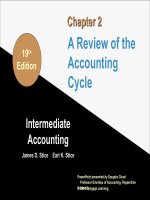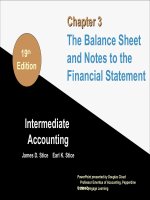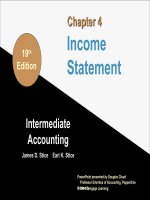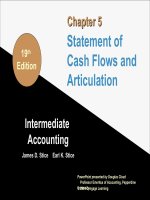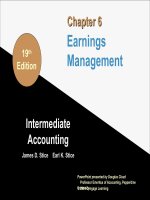Intermediate accounting 19th by stice stice chapter 17
Bạn đang xem bản rút gọn của tài liệu. Xem và tải ngay bản đầy đủ của tài liệu tại đây (201.7 KB, 71 trang )
Chapter 17
19th
Edition
Employee
Compensation—Payroll,
Pensions, and Other
Compensation Issues
Intermediate
Accounting
James D. Stice
Earl K. Stice
PowerPoint presented by Douglas Cloud
Professor Emeritus of Accounting, Pepperdine
University
© 2014 Cengage Learning
17-1
Payroll and Payroll Taxes
Social security and income tax legislation impose
five taxes based on payrolls:
1. Federal old-age, survivors’, and disability (tax to
both the employee and employer)
2. Federal hospital insurance (tax to both
employer and employee)
3. Federal unemployment insurance (tax to
employer only)
4. State unemployment insurance tax (tax to
employer only)
(continued)
17-2
Payroll and Payroll Taxes
5. Individual income tax (tax to employee only but
withheld and paid by employer)
17-3
Federal Old-Age, Survivors’,
and Disability Tax
•
•
•
The Federal Insurance Contributions Act
(FICA) provides for FICA taxes from both
employers and employees to provide funds
for federal old-age, survivors’, and disability
benefits for certain individuals and members
of their families.
The employer is required to withhold FICA
taxes from each employee’s wages.
In 2010, annual wages up to $106,800 were
subject to 6.20% for FICA tax.
17-4
Federal Hospital Insurance
•
•
•
The Federal Insurance Contribution Act
(FICA) also includes a provision for
Medicare tax.
This tax differs from the tax previously
discussed in that the tax is applied to all
wages earned; there is no upper limit.
The tax rate for 2010 was 1.45% for both
employer and employee.
17-5
Federal Unemployment Insurance
•
•
The Federal Social Security Act and the
Federal Unemployment Tax Act (FUTA)
provide for the establishment of
unemployment insurance plans.
Employers with insured workers employed
in each of 20 weeks during a calendar
year or who pay $1,500 or more in wages
during a calendar quarter are affected.
(continued)
17-6
Federal Unemployment Insurance
•
•
•
•
Tax rate on the first $7,000 of wages earned
has been 6.2% since 1985.
Employer can apply for a credit limited to
5.4% for taxes paid on state unemployment
tax, effectively reducing the federal tax to
0.8% (6.2% – 5.4%).
No tax is levied on the employee.
Payment to the federal government is
required quarterly.
17-7
State Unemployment Insurance
•
•
State unemployment compensation laws
(SUTA) are not the same in all states. In
most states, laws call for tax only on
employers, but a few states tax both
employer and employee.
Although the normal rate on employers may
be 5.4%, states have merit rating or
experience plans providing for lower rates
based on employer’s individual employment
experiences.
17-8
Income Tax
•
Federal income taxes on the wages of
individuals are collected in the period in
which the wages are paid.
•
The “pay-as-you-go” plan requires
employers to withhold income tax from
wages paid to their employees.
•
Most states and many local governments
also impose income taxes on the earnings
of employees that the employer must
withhold and remit.
(continues)
17-9
Income Tax
• Withholding is required not only of
employers engaged in a trade or business
but also of religious and charitable
organizations, educational institutions,
social organizations, and governments of
the United States, the states, the territories,
and their agencies, instrumentalities, and
political subdivisions.
17-10
Accounting for Payroll Taxes
Salaries for the month of January for a retail
store are $16,000. The SUTA tax rate is 5.4%.
Withholdings are $1,600 and FICA tax rate is
7.65%. The employer records the payroll as
follows:
Salaries Expense
FICA Taxes Payable
1,224
Employees Income Taxes Payable
1,600
Cash
13,176
16,000
To record payment of payroll and
related employee withholdings.
(continued)
17-11
Accounting for Payroll Taxes
The employer’s payroll tax entry is as follows:
Payroll Tax Expense
FICA Taxes Payable
1,224
State Unemployment Taxes Payable
864
Federal Unemployment Taxes
Payable
128
2,216
$16,000 ×
To record payment of payroll and related
.008 (0.062 $16,000
– 0765 ×
employee withholdings.
0.054) × $16,000 0.054
(continued)
17-12
.
Accounting for Payroll Taxes
The salaries and wages accrued at December 31
were $9,500. Of this amount, $2,000 was subject
to unemployment taxes and $6,000 to FICA tax.
The adjusting entry for the employer’s payroll
taxes would be as follows:
Payroll Tax Expense
0.0765
××
0.0765
FICA Taxes Payable
0.054
××
$6,000
0.054
$6,000
459
0.008
$2,000
0.008 ××
$2,000
State Unemployment Taxes Payable
$2,000
$2,000
108
FUTA Payable
16
To accrue the payroll tax liability of the
employer.
583
17-13
Compensated Absences
•
•
Compensated absences include payments
by employers for:
Vacations
Holidays
Illnesses
Other personal activities
The longer an employee works for a
company, the longer the vacation allowed or
the more liberal the time allowed for
illnesses.
(continued)
17-14
Compensated Absences
•
•
•
At the end of any given period, the firm has a
liability for the earned but unused
compensated absences.
The estimated amounts earned must be
charged against current revenue and a
liability established for that amount.
The difficult part comes when estimating how
much should be accrued.
(continued)
17-15
Compensated Absences
The FASB, in ASC paragraphs 710-10-25-1
through 3, requires a liability to be recognized
for compensated absences that:
1. have been earned through services already
rendered
2. vest or can be carried forward to
subsequent years, and
3. are estimable and probable.
17-16
Stock-Based Compensation
and Bonuses
•
In addition to stock options, employees
often earn bonuses based on a
company’s performance over a given
period of time.
•
This additional compensation should be
recognized in the period in which it is
earned.
(continued)
17-17
Stock-Based Compensation
and Bonuses
•
Photo Graphics, Inc. gives its store
managers a 10% bonus based on
individual store earnings.
•
The bonus is to be based on income
after deducting the bonus, but before
deducting income taxes. Income for a
particular store is $100,000 before
charging any bonus or income taxes.
(continued)
17-18
Stock-Based Compensation
and Bonuses
B = 0.10($100,000 – B)
B = $10,000 – 0.10B
B + 0.10B = $10,000
1.10B = $10,000
B = $9,091 (rounded)
PROOF:
PROOF:BB== 0.10($100,000
0.10($100,000–– B)
B)
BB == 0.10($100,000
0.10($100,000––$9,091)
$9,091)
BB == 0.10($90,909)
0.10($90,909)
BB == $9,090.90
$9,090.90or
or $9,091
$9,091
17-19
Postemployment Benefits
•
•
•
•
Because of downsizing, an employee cannot
count on remaining with one employer for his
or her entire career.
Some employees change jobs to facilitate
career advancement and to enhance their
family’s quality of life.
It is common for an employee to be
terminated.
Compensation issues following employment
but preceding retirement have increased in
magnitude.
(continued)
17-20
Stock-Based Compensation
and Bonuses
•
•
Examples of the types of benefits granted
to terminated employees include:
Supplemental unemployment benefits
Severance benefits
Disability-related benefits
Job training and counseling
And, continuation of benefits such as:
Health care benefits
Life insurance coverage
17-21
Accounting for Pensions
Financing retirement years is accomplished
by establishing some type of pension plan
that sets aside funds during an employee’s
working years so that at retirement the funds
and earnings from investment of the funds
may be returned to the employee in lieu of
earned wages.
(continued)
17-22
Accounting for Pensions
In the United States, three major categories of
pension plans have emerged:
1. Government plans, primarily Social
Security
2. Individual plans, such as individual
retirement accounts (IRAs)
3. Employer plans
(continued)
17-23
Accounting for Pensions
Postretirement benefits other than pensions
extend benefits beyond the active years of
employment and include such items as:
• Health care
• Life insurance
• Legal services
• Special discounts on items produced or
sold by the employer
• Tuition assistance
17-24
Funding of Employer Pension Plans
•
•
•
ERISA requires companies to fund their
pension plans in an orderly manner so that
the employee is protected at retirement.
Noncontributory pension plans are
funded entirely by the employer.
Plans where the employee also contributes
to the cost of the plan are referred to as
contributory pension plans.
(continued)
17-25



